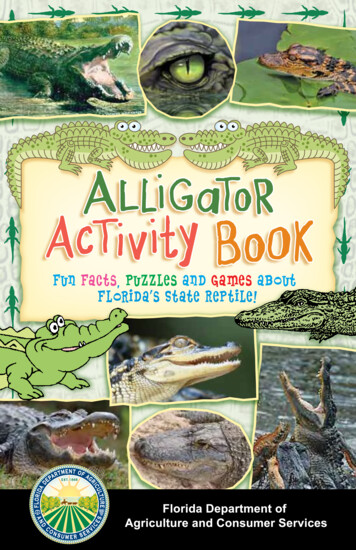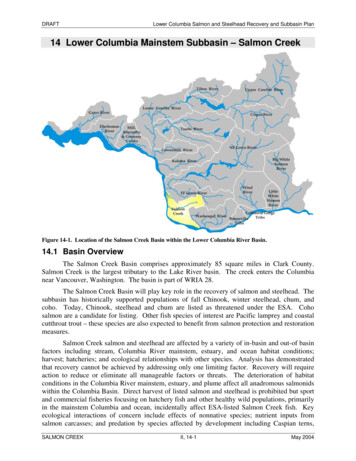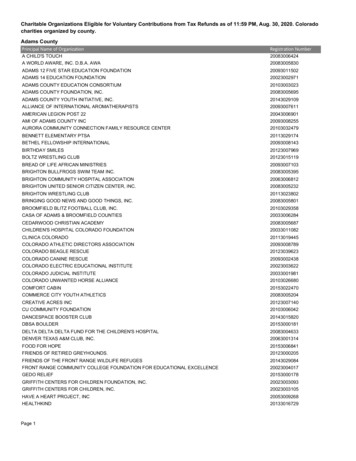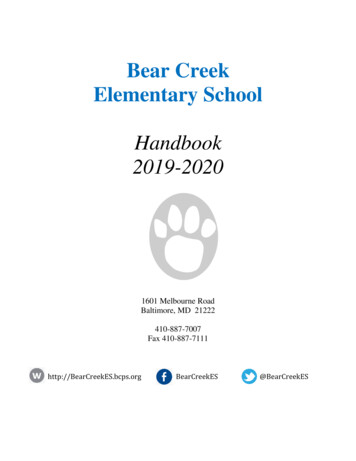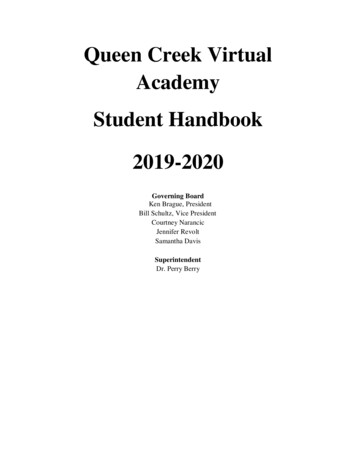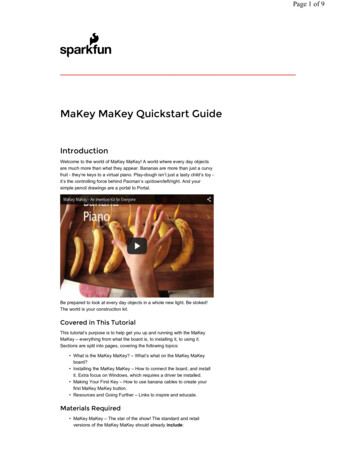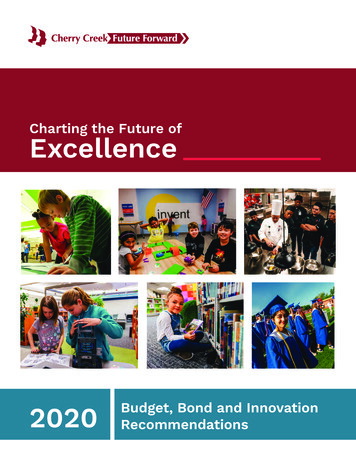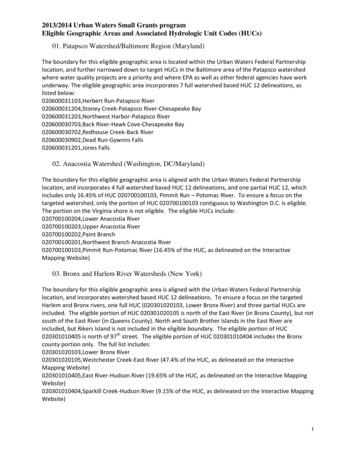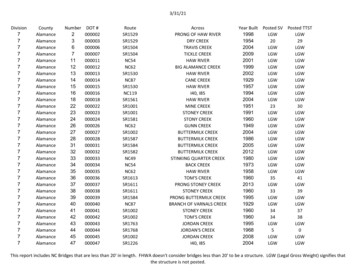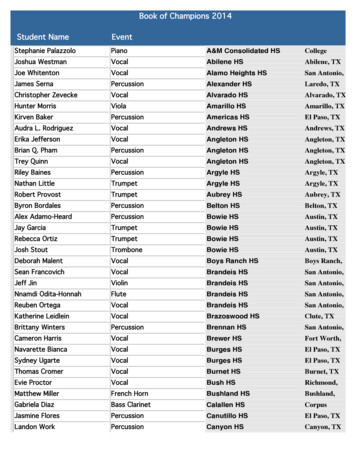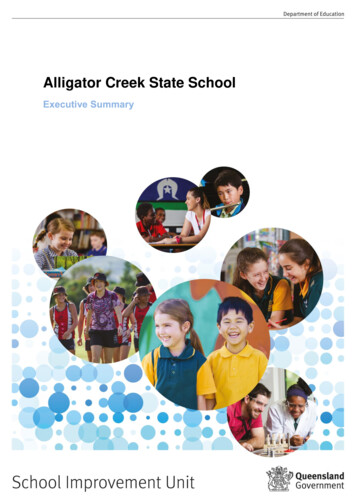
Transcription
Alligator Creek State School
Contents1. Introduction . 31.1 Review team . 31.2 School context . 41.3 Contributing stakeholders . 51.4 Supporting documentary evidence. 52. Executive summary . 62.1 Key findings . 62.2 Key improvement strategies . 92
1. IntroductionThis report is a product of a review carried out by a review team from the SchoolImprovement Unit (SIU) at Alligator Creek State School from 25 to 27 March 2019.The report presents an evaluation of the school’s performance against the nine domains ofthe National School Improvement Tool. It also recommends improvement strategies for theschool to implement in consultation with its regional office and school community.The report’s executive summary outlines key findings from the review and key improvementstrategies that prioritise future directions for improvement.Schools will publish the executive summary on the school website within two weeks ofreceiving the report.The principal will meet with their Assistant Regional Director (ARD) to discuss the reviewfindings and improvement strategies.For more information regarding the SIU and reviews for Queensland state schools pleasevisit the SIU website.1.1 Review teamDarren MarshInternal reviewer, SIU (review chair)Mona AnauPeer reviewerGraham TrevenenExternal reviewer3
1.2 School context4Location:Grasstree Road, Alligator CreekEducation region:Central Queensland RegionYear opened:1896Year levels:Prep to Year 6Enrolment:325Indigenous enrolmentpercentage:7.8 per centStudents with disabilityenrolment percentage:1.6 per centIndex of Community SocioEducational Advantage(ICSEA) value:965Year principal appointed:2018Day 8 Staffing teacher fulltime equivalent (FTE):14.6Significant partnerschools:Sarina State School, Sarina High State SchoolSignificant communitypartnerships:Dalrymple Bay and Billiton Mitsubishi Alliance’s (BMA),chaplaincy, Conservation Volunteers Australia(CVA)/Landcare Australia, Bendigo BankSignificant schoolprograms:BMA read, chaplaincy
1.3 Contributing stakeholdersThe following stakeholders contributed to the review:School community: Principal, deputy principal, Head of Curriculum (HOC), 14 teachers, instrumentalmusic teacher, teacher librarian, Health and Physical Education (HPE) teacher,special needs teacher, Business Manager (BM), administration officer, eight teacheraides, chaplain, cleaner, facilities officer, systems technician officer, Parents andCitizens’ Association (P&C) secretary and treasurer, 38 parents and 68 students.Community and business groups: Local chaplaincy committee Chair, Landcare Australia representative and BMA readprogram coordinator.Partner schools and other educational providers: Principal Sarina State School, principal Sarina State High School, principal KoumalaState School, kindergarten - Grandma’s Place representative, Kidscollege Sarinarepresentative, Police-Citizens Youth Club (PCYC) Outside School Hours Careprovider and Early Childhood Education and Care (ECEC) director.Government and departmental representatives: ARD.1.4 Supporting documentary evidence5Annual Implementation Plan 2019Team meeting minutesInvesting for Success 2019Strategic Plan 2016-2019Headline Indicators (October, 2018)School Data Profile (Semester 2, 2018)OneSchoolSchool budget overviewProfessional learning plan 2018/2019Curriculum planning documentsAlligator Creek State School Staff DiaryYearly Planner 2019School pedagogical frameworkLearning Walks protocols and policySchool Opinion SurveySchool/class newsletters and websiteSchool curriculum, assessment planResponsible Behaviour Plan for StudentsReport cardsAttendance policyModeration policyInclusive education policyCommunity engagement planAction plans for reading and numeracyPrep transition planWellbeing planSchool data plan – monitoringinstruments 2019Reading planning reference
2. Executive summary2.1 Key findingsThe tone of the school is warm and welcoming, and reflects a school-widecommitment to supporting social emotional wellbeing and student learningachievement.Positive and caring relationships are apparent in classrooms and throughout the school.Parents speak positively of staff and all aspects of the school. Students identify that teachersexpect them to do their best. The school promotes and maintains an environment reflectiveof its expectation that students will have the opportunity to learn successfully. SchoolOpinion Survey (SOS) 2018 data indicates high levels of satisfaction from staff and students.100.0 per cent of staff members agree with the statements ‘I am proud to tell others I workfor my school’, ‘This is a good school’ and ‘I would recommend my school as a good place towork’. Students indicate 100.0 per cent agreement with ‘My teachers expect me to do mybest’ and ‘I am getting a good education at my school’.Staff members are committed to supporting improved learning outcomes forstudents.There is a united purpose and commitment of staff to student learning, and an underpinningbelief that all students are able to learn and achieve successfully through a culture of highquality teaching and systems that support learning achievement. Parents recognise that staffare highly visible across the school, working closely with parents, students and the widercommunity. Parents articulate that staff members demonstrate dedication, commitment andsupport for students and that this is strongly valued within the school community.The Explicit Improvement Agenda (EIA) is reflected in the Annual Implementation Plan(AIP) and outlines the major improvement priority as consistent improvement in theteaching and learning of reading.The minor improvement priority areas of the EIA include embedding the improvementstrategies in the teaching and learning of numeracy and building a teaching and learningculture. Teaching staff members clearly articulate that reading is the school’s priorityimprovement area. Teachers indicate that they are unsure of some of the strategies to beused to improve student achievement in the major priority area of reading, includingimplementation timelines and targets.The school’s 2019 curriculum and assessment plan is aligned to the AustralianCurriculum (AC).Teaching staff members utilise the school’s curriculum planning process to develop theteaching and learning sequence of the intended curriculum. Half-day planning sessionsknown as pre-moderation are provided to teachers in year levels to plan units of work for theupcoming term. The leadership team acknowledges that the curriculum plan requires furtherdevelopment to include areas of the general capabilities and cross-curriculum priorities ofthe AC.6
The school’s pedagogical framework is based on a number of research-basedapproaches.The main pedagogies implemented at the school include Explicit Instruction (EI), the GradualRelease of Responsibility (GRR) model and Hattie’s1 visible learning with a focus on learningintentions and success criteria. Teachers articulate that their understanding andimplementation of the pedagogical framework are developing. Staff members indicate thatclarity regarding the expected practices of the pedagogy framework is emerging.There is acknowledgement from the leadership team that high quality teaching is thekey to student learning improvement.Teachers express that Professional Development (PD) opportunities are provided to staffmembers to support the implementation of programs and teaching strategies implemented atthe school. A process of learning walks is conducted each term to provide feedback to staffregarding student learning progress. The ongoing detailed feedback on classroom practiceincluding the routine evaluation of the effectiveness of the expected pedagogical practice toinform adjustments to teaching is yet to be systematically implemented.The principal and staff members express the belief that all students are capable oflearning successfully when motivated and given the appropriate support andopportunities to demonstrate their learning.The school is inclusive in its approach towards supporting all students. Teachers work toprovide curriculum at the appropriate level for students’ needs. Individual Curriculum Plans(ICP) are developed for students identified as operating below year level standards. ICPsare developed in collaboration with parents, specialist staff and the class teacher. Theleadership team acknowledges that a review of the school’s ICP policy is required to ensureappropriate identification and support processes are implemented at the school.Students speak positively of the efforts of their teachers and teacher aides inproviding interesting and engaging learning opportunities.Students articulate that feedback from their teacher helps to provide them with anunderstanding of how they are progressing with their learning. Teachers welcome theinclusion of all students in the classroom, including those requiring additional learningsupport. Parents comment that their child is happy at school and extremely well supportedby staff members.The school actively works to strengthen learning and wellbeing outcomes forstudents through effective partnerships between staff, students, parents and thewider-community.There are a large number of community partnerships at the school that focus on enhancingstudent learning experiences and outcomes. Engagement with and participation in the wider1Hattie, J. (2008). Visible learning: A synthesis of over 800 meta-analyses relating to achievement.New York, NY: Routledge.7
community is a focus for staff, students and families. School leaders continue to seek waysto further build parent relationships and community partnerships in the pursuit of studentlearning achievement.8
2.2 Key improvement strategiesCollaboratively develop a narrow EIA using school performance data that includes targets,agreed strategies for implementation, timelines and success checks.Collaboratively refine and strengthen the whole-school curriculum and assessment plan toinclude all elements of the AC, including the general capabilities and cross-curriculumpriorities that are responsive to local needs and will further engage and challenge the fullrange of students.Review and refine the school’s pedagogical framework to include agreed practices that arealigned to the EIA.Collaboratively develop an agreed systematic and formalised model for teacher observation,feedback and coaching, aligned to the EIA.Review the processes regarding the identification, development and implementation of ICPs,including the support strategies and resources for classroom teachers.9
3 1. Introduction This report is a product of a review carried out by a review team from the School Improvement Unit (SIU) at Alligator Creek State School from 25 to 27 March 2019. The report presents an evaluation of the school's performance against the nine domains of
